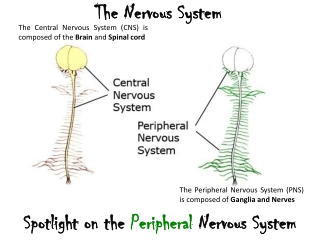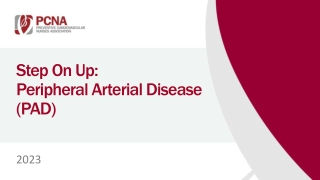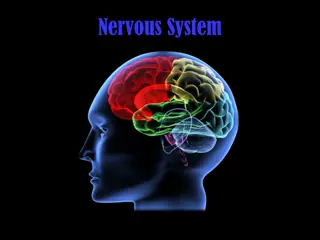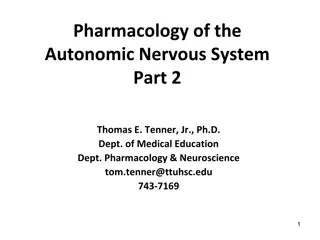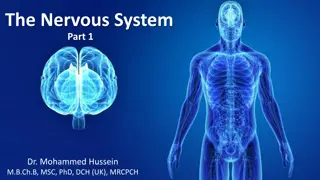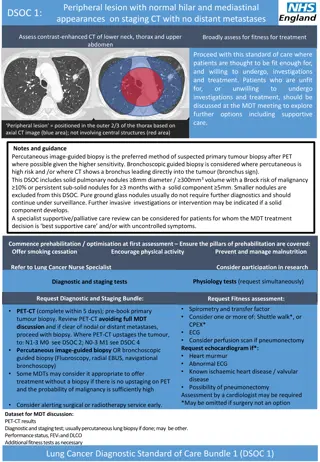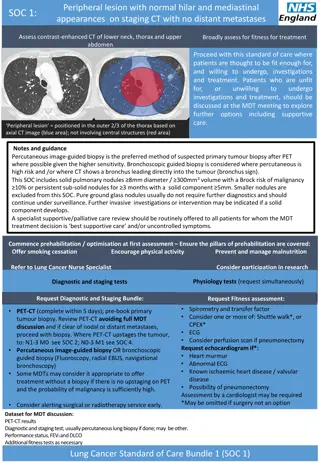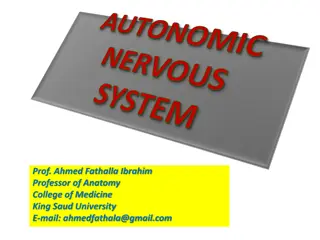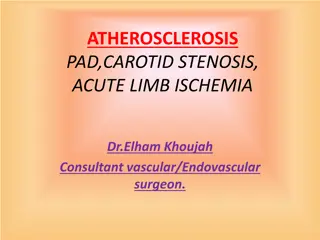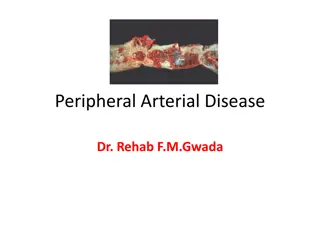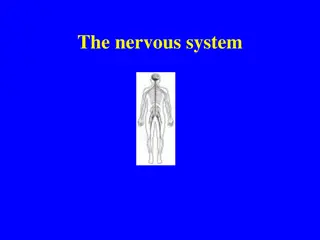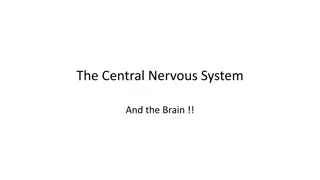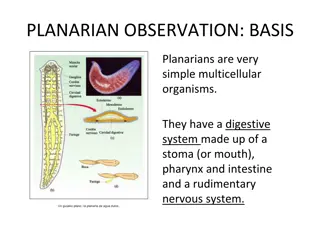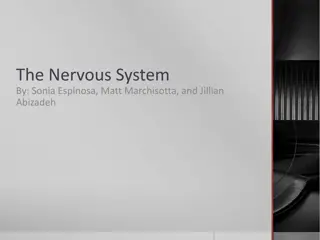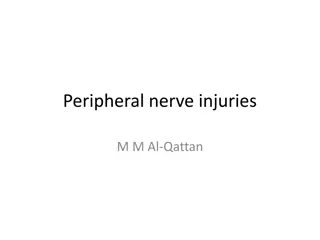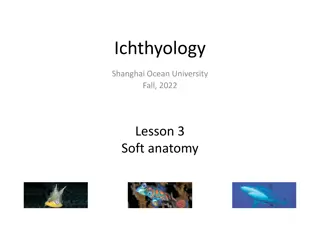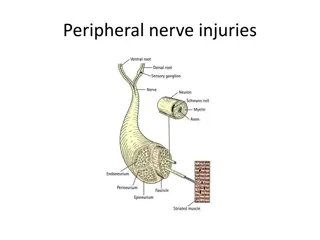The Nervous System
Central and peripheral nervous systems, as well as the somatic and autonomic nervous systems. It covers the components, functions, and control of each system, along with their effects on effector tissues.
0 views • 23 slides
Step On Up: Peripheral Arterial Disease (PAD)
Peripheral Arterial Disease (PAD), a condition caused by reduced blood flow in the legs or arms. Understand the symptoms, signs, importance of early detection, and who is at risk. Find out about the tests for PAD.
0 views • 18 slides
Understanding the Nervous System: CNS, PNS, SNS, and ANS
The nervous system comprises the Central Nervous System (CNS) and Peripheral Nervous System (PNS), with the PNS further divided into the Somatic Nervous System (SNS) and Autonomic Nervous System (ANS). The SNS controls voluntary movements of skeletal muscles, while the ANS regulates involuntary proc
2 views • 23 slides
Best Neurosurgeons in India
A neurosurgeon is a specialized trained doctor who diagnoses and treats patients who suffer from nervous system problems including the brain, and spinal cord. Neurosurgeons complete their specialist training in neurosurgery which may take between 5 to 9 years. Neurosurgeons perform surgery on the ne
1 views • 3 slides
Comprehensive Overview of the Nervous System
Explore the anatomy and functions of the nervous system with details on its subdivisions, brain parts, spinal cord features, cranial nerves, and more. Learn about sensory input collection, integration, and motor output functions. Understand the structural and functional organization of the central a
0 views • 23 slides
Understanding Strength-Duration (SD) Curve: A Neuromuscular Diagnostic Test
Strength-Duration (SD) curve is a diagnostic test assessing neuromuscular integrity by measuring the relationship between stimulus strength and duration. It helps in electro-diagnosis of peripheral nervous system disorders and evaluates nerve degeneration and regeneration. The curve is obtained by p
2 views • 17 slides
Pharmacology of the Autonomic Nervous System Part 2 Summary and Learning Objectives
Explore the pharmacology of the autonomic nervous system focusing on cholinergic and adrenergic agents. Learn about cholinomimetics, direct and indirect acting cholinergic agonists, their therapeutic indications, and adverse effects. Discover the mechanism of action and uses of nicotinic agonists. D
1 views • 44 slides
Understanding the Basics of the Nervous System with Dr. Mohammed Hussein
Explore the fundamentals of the nervous system in Part 1 with Dr. Mohammed Hussein, covering nerve cells, cellular processes, types of neurons, nerve structure, blood vessels, grey matter, and afferent and efferent neurons. Gain insights into the key components that make up this intricate system.
0 views • 12 slides
Understanding Membrane Proteins and Cell Membrane Permeability
Cell membranes consist of phospholipid bilayers with embedded proteins, including integral and peripheral proteins. Integral proteins span the membrane, while peripheral proteins interact with the surface. Only non-polar molecules can pass through the membrane directly, while charged ions, polar mol
0 views • 30 slides
Understanding Computer Peripheral Devices: Definition, Examples, and Types
Learn about computer peripheral devices, which enhance a computer system's functionality. Examples include mice, keyboards, monitors, printers, and scanners. These devices can be categorized into input, output, and storage devices, each serving a specific purpose to expand the capabilities of your c
2 views • 13 slides
Transcriptomic Changes in Peripheral Blood Mononuclear Cells of International Space Station Crew Members
The study analyzed transcriptomic changes in peripheral blood mononuclear cells of International Space Station crew members. Blood samples were collected before and after spaceflight, and differentially expressed genes were identified using RNA-seq analysis. Several genes, including CDKN1A (p21) and
0 views • 12 slides
Understanding Cyanosis: Causes, Types, and Clinical Differentiation
Cyanosis is characterized by a bluish discoloration of the skin and mucous membranes due to increased levels of reduced hemoglobin. This condition can be categorized as central or peripheral cyanosis, each with distinct characteristics and causes. Central cyanosis results from decreased oxygen satur
0 views • 13 slides
Standard of Care for Peripheral Lesion Assessment in Lung Cancer
The provided guidelines outline the standard care pathway for assessing peripheral lesions in lung cancer patients based on staging CT findings. It includes recommendations for biopsy methods, fitness assessment, PET-CT imaging, and considerations for treatment decisions. The protocol emphasizes tai
0 views • 5 slides
Understanding Adrenergic Transmission and Catecholamine Synthesis
Adrenergic transmission involves the release of neurotransmitters such as norepinephrine, dopamine, and epinephrine at synapses or neuroeffector junctions. These neurotransmitters, known as catecholamines, play crucial roles in transmitting impulses in the sympathetic nervous system and central nerv
0 views • 14 slides
Standard of Care for Peripheral Lesion Assessment with Normal Hilar and Mediastinal Appearances
Assessing patients with peripheral lesion on staging CT with normal hilar and mediastinal findings. Further investigation with contrast-enhanced CT is recommended for fitness evaluation and treatment planning. Biopsy methods, diagnostic criteria, and considerations for nodules and nodal staging are
4 views • 5 slides
Understanding the Autonomic Nervous System in Anatomy Lecture
In this anatomy lecture by Prof. Ahmed Fathalla Ibrahim from King Saud University, students will learn about the autonomic nervous system. The objectives include defining the system, describing its structure, and tracing neurons in both sympathetic and parasympathetic systems. The lecture also cover
1 views • 17 slides
Understanding the Nervous System and Sensory Neurons
The nervous system plays a crucial role in connecting the central nervous system (CNS) to limbs and organs through the peripheral nervous system (PNS). It consists of sensory neurons that transmit impulses from sensory receptors to the CNS, allowing us to perceive and respond to various stimuli. The
0 views • 23 slides
Understanding Atherosclerosis, Peripheral Artery Disease, and Carotid Stenosis
This informative content details the histo-anatomy of blood vessels, pathophysiology of atherosclerosis, peripheral ischemia, and carotid artery disease. It covers the definition, risk factors, and processes involved in atherosclerosis, including endothelial cell function, blood flow dynamics, and f
3 views • 24 slides
Understanding Peripheral Arterial Disease (PAD) - Overview and Management
Peripheral Arterial Disease (PAD) refers to the narrowing of blood vessels outside the heart and brain, leading to reduced blood flow. This condition can result from atherosclerosis, inflammation, embolism, or thrombus formation. Learn about the causes, symptoms, diagnosis, and treatment strategies
5 views • 34 slides
Screening for Peripheral Vascular Disease in Patients with Coronary Artery Disease
Patients with coronary artery disease should be screened for peripheral vascular disease as it is a frequent integrator of global cardiovascular risk. The association of atherosclerosis in various arterial diseases highlights the importance of identifying multisite artery disease. The prevalence and
0 views • 23 slides
Understanding the Nervous System: Functions, Sense Organs, and Reflex Actions
The nervous system, consisting of the brain, spinal cord, and nerves, is crucial for sensing and responding to stimuli in our environment. Sense organs like the eyes, ears, and skin help detect changes, while reflex actions provide immediate responses. Synapses and neurotransmitters play a role in t
0 views • 14 slides
Understanding the Central Nervous System and Brain
The central nervous system plays a crucial role in enabling organisms to respond to stimuli and adapt to changes in the environment. Comprising receptors, neurones, and effectors, this system facilitates the detection of stimuli, transmission of messages, and appropriate responses. Neurones, includi
0 views • 18 slides
Understanding the Nervous System: A Comprehensive Overview
The nervous system consists of the central nervous system (CNS) and peripheral nervous system (PNS), with neurons as its basic unit. Neurons function as sensory, associative, and motor types, carrying impulses within the body. Parts of a neuron include the cell body, dendrites, axon, and terminal en
2 views • 86 slides
Verbal Mismatch and Phonological Identity in Peripheral Ellipsis
The study delves into verbal mismatch and phonological identity in peripheral ellipsis, covering topics such as syntactic mismatches, peripheral ellipsis and mismatch, and stricter identity requirements in peripheral ellipsis compared to other types of ellipsis. Various examples and analyses are pre
0 views • 49 slides
Understanding Opioids: Pharmacology and Clinical Applications
Opioids are essential in treating severe and chronic pain, whether malignant or nonmalignant. They are classified based on chemical structure, aiding in identifying potential cross-sensitivity in patients. Opioid agonists interact with specific receptors in the central nervous system and peripheral
0 views • 45 slides
Understanding the Nervous System: Structure and Function
The nervous system is a complex network divided into the central nervous system (CNS) and peripheral nervous system (PNS). Neuroglia, or supporting cells, play vital roles in maintaining the health and function of neurons. Neurons, the fundamental units of the nervous system, vary in structure and f
1 views • 29 slides
Understanding Peripheral Nerve Injuries and Intervention Strategies
Peripheral nerves play a vital role in connecting the central nervous system to various parts of the body. Injuries to these nerves can result from different causes, leading to significant challenges. Early intervention is crucial in preventing irreversible damage and improving outcomes. The process
0 views • 63 slides
Approach to Headache and Neurological Symptoms in Clinical Practice
Comprehensive overview of primary and secondary headaches, red flags, and patterns in neurological presentations. Discusses distinguishing features, differential diagnoses, and management approaches for various conditions affecting the central and peripheral nervous system. Highlights important cond
0 views • 16 slides
Human Nervous System and Sensory Organs Revision 2020: Diagrams and Questions
Detailed content covering the human nervous system, eye, and ear through diagrams and questions for revision. Includes instructions on how to analyze and answer questions related to the diagrams provided in the study material. The content focuses on understanding the central nervous system, reflex a
0 views • 10 slides
Understanding Pharmacology: Introduction to Neurotransmitters and Nervous System
This content delves into the fundamentals of neuropharmacology, exploring concepts such as dose-response curves, afferent and efferent neurons, peripheral nervous system divisions, neurotransmitter functions, and neurochemical classifications. It covers the roles of cholinergic, adrenergic, and dopa
0 views • 29 slides
Planarian Observation: Nervous System Activity Study
Planarian Observation involves studying the effects of different substances on a planarian's nervous system. Through remote laboratory experiments, observations are made on the movement of planarians in various solutions compared to a control solution. Results are analyzed to determine the effects o
0 views • 7 slides
Overview of the Nervous System Components and Functions
The nervous system is comprised of the central nervous system (CNS) and the peripheral nervous system (PNS). The CNS acts as the command center, interpreting sensory information and coordinating responses. The PNS conveys information to and from the CNS through somatic and visceral sensory neurons,
0 views • 48 slides
Understanding Central vs Peripheral Blood Pressure: Clinical Relevance
Central vs peripheral blood pressure differences have clinical implications as systolic pressure amplification occurs due to changes in arterial stiffness moving away from the heart. Central pressure measurements, more closely related to cardiovascular events, provide valuable insights for assessing
3 views • 25 slides
Understanding How Hormones Interact: The Endocrine System
The endocrine system comprises glands that release hormones into the bloodstream, influencing various bodily functions. Key glands include the pituitary, pineal, thyroid, pancreas, gonads, and adrenal glands, each playing a crucial role in regulating metabolism, growth, stress response, and reproduc
0 views • 5 slides
Understanding Central and Peripheral Controls of Food Intake and Appetite
This article delves into the intricate mechanisms that regulate food intake and appetite, focusing on central and peripheral factors. Neural signals, gastric distention, glucose influence, circulating lipids' role, and gut hormones all play crucial roles in shaping our eating behavior. These signals
0 views • 15 slides
Understanding the Intricacies of the Nervous System
Delve into the intricate workings of the nervous system, encompassing the brain, spinal cord, and nerves. Explore key components such as neurons, neurotransmitters, and reflexes, essential for perceiving and responding to stimuli. Uncover the vital role of this control system in interpreting the ext
0 views • 17 slides
The Geography of New Working Spaces and Their Impact on Peripheral Areas
This presentation discusses the COST Action CA18214 focusing on new working spaces (NeWSp) and their role in promoting regional competitiveness, entrepreneurial environments, social inclusion, and spatial regeneration in peripheral areas. It explores the structure of the presentation, types of third
0 views • 18 slides
Overview of Peripheral Nerve Injuries and Brachial Plexus Injuries
Explore different types of peripheral nerve injuries including Erb's palsy, Klumpke palsy, isolated axillary nerve injury, and isolated musculocutaneous nerve injury. Learn about the anatomy, causes, motor and sensory exams, and management of these injuries. Understand the myotomes and dermatomes as
0 views • 19 slides
Understanding the Soft Anatomy of Fish Nervous System in Ichthyology
Explore the intricate details of the nervous system in fish, delving into the division of the cerebrospinal and autonomic systems, the unique characteristics of fish brains, and the segmentation of the brain into five parts from the anterior to the posterior regions. Gain insights into the functions
0 views • 19 slides
Understanding Peripheral Nerve Injuries and Pathological Classification
Peripheral nerves play a crucial role in transmitting motor and sensory impulses. Injuries to these nerves can result from various causes like ischemia, compression, traction, laceration, or burning, leading to a range of severity from transient dysfunction to complete interruptio...
0 views • 18 slides
